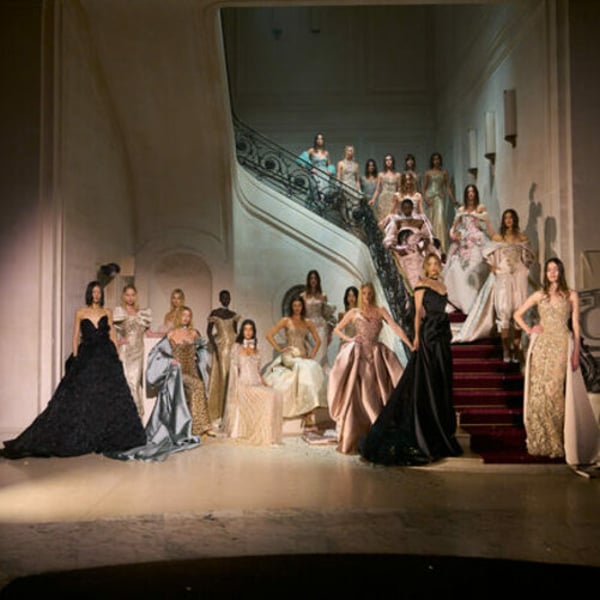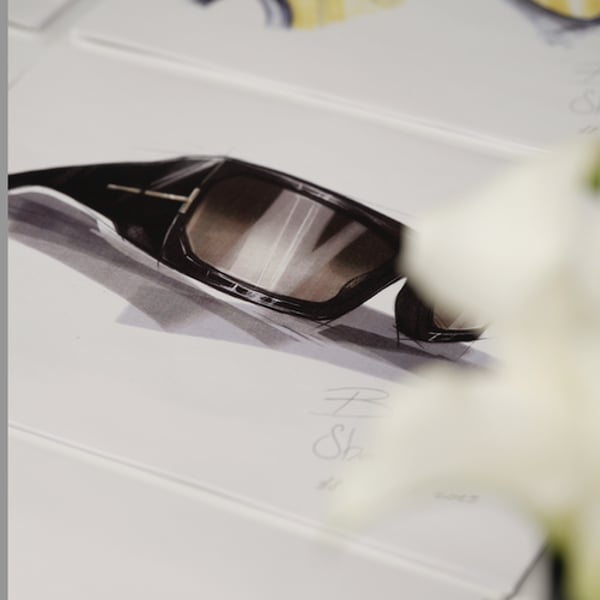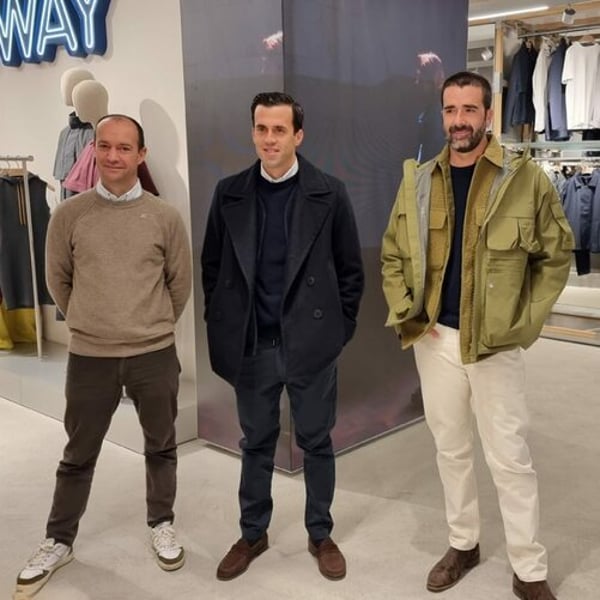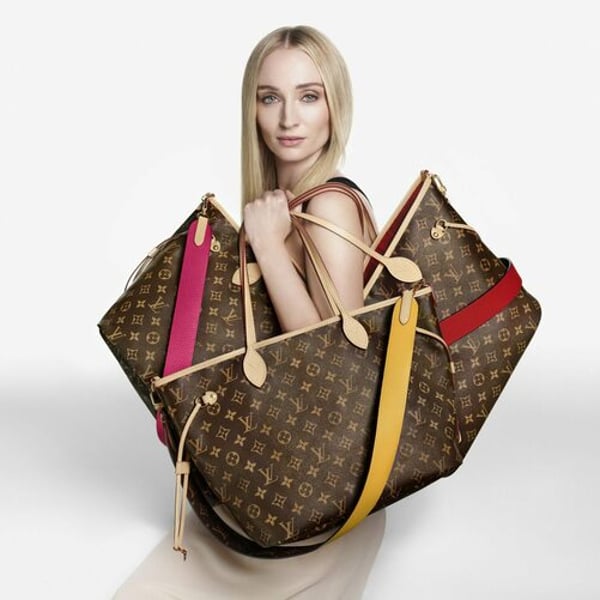Often, the greatest progenitors of couture – a very French concept – are born thousands of kilometers from France. Three such talents – Elie Saab, Fang Couture and ArdAzAei – offered up impressive visions of revived couture classicism. None of them were born in France.

Elie Saab: Royal court couture
“I dreamed of a royal court,” beamed Elie Saab, after one of his most opulent and sculptural collections to date.
Staged inside the Pavillon Cambon, opposite Chanel’s HQ, the cast marched down the Belle Époque wrought-iron staircase into a packed house for the Lebanese couturier’s latest show.
Keeping to the regal theme, Elie sent out three veteran runway princesses to open the show. The ever-defiantly moody Dutch blonde beauty Lara Stone, swaddled in charcoal and crème caramel silk shantung, sculpted into a stunning gown.

Russian beauty Sasha Pivovarova followed up in a décolleté black velvet jacket, laced at the back, and paired with crepe knickerbockers and a moiré satin train. Isabeli Fontana completed the trilogy in a va-va-vroom curvy velour gown, held together with diagonal lace stitching.
Their hair left tousled, the throats looped in black ribbon, this was the sexiest Saab opening in eons. And no harm in that.
Then Elie sent his famous atelier into overdrive with beautiful gowns made in magnified spring flowers, finished with bugle beading, strass and crystals.
One technique of knotting folds of fabric at the front, used on duchess satin gowns, was the work of a master couturier working his magic. While his pyramidal pink feather dress was a work of astounding skill, as was his reinvented and seductive French corsetry.

Composed in a fresh macaron palette of nude, rose coral pink, faint blue, and mint, with dollops of imperial black and gold, this felt like a magnificent court.
For those who desire their couture to blend beauty with technical excellence, Saab and his atelier are second to none on their day. No wonder Elie won a standing ovation. As the cast assembled on the staircase, he took his familiar modest bow.
Fang Couture: Zhezhi chic at the Eiffel Tower

East dialogued with West this season at Fang Couture, an elegant indie label that staged its first show on a terrace facing the Eiffel Tower.
Created by China-born Fang Yang, a graduate of noted Paris fashion college Esmod, Fang is all about blending great European fabrics and silhouettes with clever Chinese techniques.
The collection’s key idea was using Zhezhi, the Chinese art of paper folding, a little like their version of origami, which ranged from handkerchiefs folded into wee flowers to some beguiling dresses made of dexterously folded duchess satin. The result was a very refined series of folded lattice dresses, such as a ruby red sheath finished with tiny buds of jade beads.

Fang founded the brand with her life partner Grégoire Caillol, and together they have dreamed up a marque with a distinctive point of view. In 2015, she opened the couture maison By Fang.
Fang also showed breastplate tops made in puckered black organza finished with crystals, or a pair of beautiful chiffon lattice bustier dresses decorated with tiny amethysts – in red or softer beige.
“I wanted to work with silk and other fabrics the way I had worked with paper. It’s a homage to my heritage and also to my idea of Parisian elegance,” explained Fang in a pre-show preview.
As the sun descended, Yang staged her show, the refined delicacy of the clothes happily contrasted by the raw power of the tower across the Seine. East rather at ease with the West, just like this collection.
ArdAzAei: Folded sea, fine food

Charles Darwin would have loved the latest collection by ArdAzAei, and the audience certainly did too.
Darwin believed – quite rightly – that the origin of life was the meeting of land and sea, which was why he studied mollusks on the shores of the North Sea, while a student at the University of Edinburgh. Like the great scientist, ArdAzAei’s designer Bahareh Arkadani found inspiration from the sea, more specifically the sea urchin, with its unlikely pentaradial geometry and mythical status as “talismans of protection.”
Entitled The Folded Sea, the collection played on the ideal shape of sea urchins, whose shells decorate seaside homes from Galway to Gothenburg, Nantes to Naples.
The result was a hyper-original collection of undulating shapes, ribbed formers, and unexpected drama. Suggesting the curvature of a bivalve with opening black crepe blazers and bustier dresses. The glistening finish of crustaceans in techy ecru pantsuits. Or playing visually on a stormy sea in a superb, layered lurex gown, finished with bold cut-outs. Everything looked elegant and noble in the midday light of the airy ground floor of the Cartier Foundation. To ArdAzAei fell the honor of being the first couture house to show there since the art center’s recent restoration, in some savvy management.

Though highly eco-conscious, Arkadani is not afraid to use advanced fabrics – like the “armor-plated” cocktail with protective straps that sat three inches off the shoulders, made of silk, cotton and stainless steel.
Arkadani could do with a little self-editing. Quite a few looks had one too many swirls, dissections or ruffles. But this was still a special fashion statement, using the power of fabric and fashion imagery to suggest a more beautiful, and understanding, world.
Staged at a slow speed, surprisingly to a soundtrack that included a lovely quirky industrial track named Metabolism by Baintermix, this was one of those shows one only ever sees in Paris couture.
Celebrated with delightful food courtesy of the happening Danish chef Claus Meyer, a new star of Nordic cuisine. Hand-dived scallops on caviar with white sturgeon caviar, topped by a sprinkling of fennel. Oyster emulsion with pickled cucumber and flowers, all washed down by an excellent Spanish biodynamic wine, Can Sumoi Ancestral Montonega.
Come to think of it, Darwin would have approved of the food too.
Copyright © 2025 FashionNetwork.com All rights reserved.







